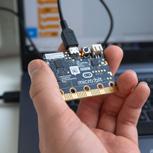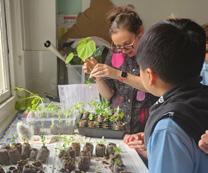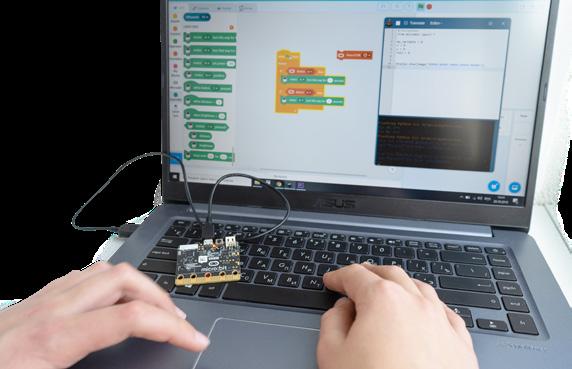




Term 4 already! How has your year with technology been thus far? T4L released the Beginning Teacher Tech Guide in Term 1 and it’s been one of our biggest reads ever – so don’t forget to share it with colleagues new to the classroom. In this edition we unpack the new T4L Kids magazine focused on growing a business, we explore some of our favourite tools and share some of our winning tips with you. Share this resource at your next staff meeting and check out our back issues to keep you inspired.
Linda Lazenby Director, Digital Teaching and Learning

 Digital Learning Advisor
Digital Learning Advisor
Tell us about your current role with the Digital Support Team. What’s been a highlight?
I support teachers to integrate technology into their lessons. It’s about supporting them to choose the best piece of technology to complete a task, designing new tasks that could not have previously been completed without technology and to create engaging learning opportunities for our students. I also mentor some of our Digital Classroom Officers in high schools in my region.
What has your teaching pathway been?
I’ve been a science teacher for thirteen years before joining the stem.T4L team, then the Digital Support Team in order to deliver on the outcomes of the Rural Access Gap. As a science teacher I have taught Biology, Chemistry, Physics and Junior Science. While on maternity leave many years ago, I would present science lessons in the local preschools and primary schools to excite the younger students to help build skills and enthusiasm for science.
What do you wish you’d known about tech in the DoE in the beginning?

All of the free resources that are available for teachers. We have so many platforms we can access. T4L, stem.T4L, Digital Learning Selector, Universal Resources Hub , Statewide Staffroom just to name a few. Also, how beneficial the Viva Engage (Yammer), platform can be. Utilising social media to build tech skills in small chunks to learn how others integrate tech into their classroom.
The technology underutilised would be Edge Collections. I absolutely love being able to create folders of resources, add sticky notes related to why I plan to use a resource and have all the tabs open with one click when presenting on Main Learning Displays around the state. I also love how easy it is to share all of the resources in the folder in one note or word for programming and include a bibliography. I’ve also been the micro:bit Australian lead – check out page 4 for more on this!

Canva for Education is now just a click away for NSW public school teachers and students. Learn more about your classes and your school account here


Prototyping with Adobe has never been easier to unpack with this on-demand resource, especially for teachers from the T4L team.



Do you have enterprising secondary students? The department has created the iEntrepreneur resource kit for secondary schools including crafted lessons, e-learning modules for teachers and student worksheets for those keen to embrace the power of entrepreneurial learning. Schools involved this year took part in the Innovation Challenge and came together at a symposium to share their school’s entrepreneurial progress. If you’re keen to know more, head here. You can find the e-learning modules on MyPL.

I have been a micro:bit champion and Australian micro:bit lead for the last few years. 39 million students across more than sixty countries have used the micro:bit for learning. It allows students from the age of 8-18 to code (block or text-based) or collect data from a physical device.
My favorite lesson is related to collecting environmental data. Students can measure light, sound and soil moisture with the micro:bit in the garden through the built in sensors. Increasing the difficulty by collecting the temperature, light and sound levels remotely through the built in radio to a micro:bit that is connected via USB to a computer.


Explore Issue 24 of magazine.T4L for more on the power of microcontrollers.

Book a microcontroller kit from stem.T4L and explore the video resources.

Explore micro:bit projects using MakeCode, Python and Scratch on the official site.

 BOOK A KIT
BOOK A KIT


T4L recently had the pleasure of hosting the RoboRebels from Narooma High, who this year participated in the FRC (FIRST® Robotics Competition) World Robotics Championships hosted in Houston, Texas. The RoboRebels were one of seven Australian schools participating in the major event , and the only school representing the NSW DoE. The team built ‘Noodle’, a ground intake robot that picks up and moves cubes around. The team of five senior students, plus their incredible support team (their teachers) put together their own special edition of T4L Kids including top tips on how to set up a robotics club in your school and created a podcast of their experiences. Share it with your keen robotics students now!
Read their T4L Kids – Robotics Special Edition

The RoboRebels in the ITD podcasting studio. Listen to the RoboRebels podcast.
Plan your technology PL in Term 4 and make sure you bookmark the T4L events page. Did you miss a session from earlier in the year? Catch up on our previous events with our on-demand content at a time that suits you. Topics covered recently include Microsoft Cloud and Google Cloud workflows, Canva Single Sign on and more.

Issue 15 is all about supporting young entrepreneurs in your class. This independent learning resource could be used as part of your programming. There is a focus on exploring social entrepreneurism for good, as well as building a business for profit.
Each issue of T4L Kids follows a design thinking process, and this issue encourages students to build a business using tech tools. Students will develop their business ideas individually or in a team.
Research and plan their business idea
Identify and define what makes their business special or unique
Test and evaluate their plan with others
Produce and implement their idea
Students have two challenges in the magazine to work through, each employing different tech tools to support them as they develop their business ideas with their colleagues/team.
thebusinesswillwork-includingwhat theyneedtosetuptheirbusiness,what localcompetitionisinthearea,andthen buildabudgetbeforetheylaunch
1
Steps 1-3
See
Researchyouridea
Whatisyourbusinessidea?Isyourgoalto makemoneyforyourself,foranorganisation orcharity,ortogrowawarenessofanissue?
Arethereotherbusinessesinyourlocalarea thatarethesame?Whatcouldyourpoint ofdifferencebe?WhatisyourUSP(unique SellingPoint?)
2
Delve into the data
Whatresearchhaveyoudoneonthetypeof businessyouwanttostart? Canyoudoanyresearchonexistingsimilar businesses
K9 Walkies:
Theteamhave researchedhowmuchotherdog walkerschargeintheirareaaswellashow theircustomersbookin.Theyaregoingto basetheirpricingonthemarketvalueandsee howtheycancreateagreatexperiencefor customerstobookin.


K9 Walkies:
Theteamdecideto prototypeandappforbookingsto managealltheirworkafterschoolandon theweekends.Theyalsocouldbuildawebsite, buthavedecidedanappwillbeeasierand quickerfortheircustomers.
8 6
CreateaspreadsheetusingExcel, Numbersorxtoaddyourdata–do thenumberswork?Howmuch moneywillyouneedtomakein ordertocoveryourbusinesscosts?
Dosomemarketresearch–set aquizorcreateaformandask peopleiftheywoulduseyour services,oreventogetmoreideas



Once students have their business idea, they will take the next steps to build their profile and promote their service or product. They will design a logo, develop a marketing plan, build an app, website or podcast and advertise their company!

For over thirty years, ARTEXPRESS has showcased and celebrated the finest HSC Visual Arts bodies of work through exhibitions at galleries around NSW. Now, thanks to an innovative approach to making the works more accessible, fifty-two bodies of work have been digitally scanned and a custom virtual gallery has been built.
The gallery and the works themselves are best experienced with a VR headset and hand controllers, and are also accessible via PCs, laptops and iPads. VR allows students to handle each of the artworks in 3D. T4L was proud to play host to the launch of the virtual gallery unveiling at the Information Technology Directorate in August.



Explore the virtual ARTEXPRESS gallery now.






By now, we’re all well and truly aware of the department’s Hot Spots service. But did you know that the T4L team presents a weekly online show that’s built around our Viva Engage community and showcases school and Education Support Staff that use it? Each show highlights amazing work happening in our schools and discusses authentic teaching and learning activities using tech in the classroom. Most of our highly tech-engaged staff use the collegiality of Viva Engage to make their work easier and have amazing stories to share. Greig and Stu find and chat with new superstars every week and help to give their stories to a wider audience. They’ve already chatted with over 160 different guests across more than 100 episodes! You can join us live every Monday afternoon during school terms at 3:30pm and chat with the crowd or catch up on any of the past episodes via the recordings. All you need to know is at the Viva Hot Spots website!

Join



The Virtual Staffroom chats with Principal Nicole Parker of William Rose School. This inspirational chat explores how assistive technologies assist students of differing needs, and Nicole also shares how no two days are the same at this incredible school.

At the end of Term 3, Illawarra and Shoalhaven schools came together for a STEM showcase at the University of Wollongong’s Innovation Campus.
Students from fourteen schools in the region have been working with mentors across the university and industry sector to develop their STEM projects ranging from robotics to app design, with a focus on sustainability, people and the environment.
‘Our goal is to build confidence and capacity in the classroom, and also build some great opportunities for industry to share ideas and provide opportunities for students in the STEM space,’ said Illawarra Academy of STEM Project Officer Russ Taunton of the Young ICT Explorer program.

The schools involved in the STEM showcase were Corrimal, Warrawong, Illawarra Sports and Shoalhaven high schools, and primary schools Bellambi, Corrimal East, Tarrawanna, Lake Heights, Kemblawarra, Farmborough Rd, Mt Brown, Berkeley and Culburra.
If you’re interested in building an app at your school, explore our T4L Kids resources around app design and development!
Students from Lake Heights Public School developed an app explaining the rules of their favourite game–rugby union. stations on public transport.
Students from Corrimal High School prototyped an app for solar mobile phone charging stations on public transport.


Students from Mt Brown Public School developed the ‘Job Bot’ for newly arrived Australians connecting them with work opportunities in their local area, guided by the UN principle working towards immigrant equality.


